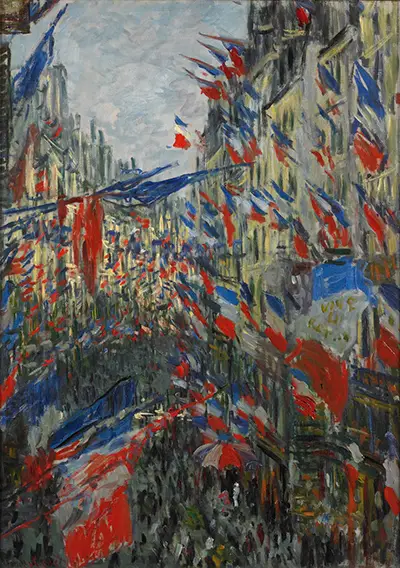This seemingly almost spontaneous celebration was to mark the end of the Universal Exhibition. The other painting depicts a near identical scene on Rue Montorgueil, both of street party scenes viewed from balconies high above the festivities below.
Both paintings make heavy use of the french red, white and blue tricolor mainly in the form of flags which Monet expertly depicts their motion flowing in the breeze.
The painting is 81cm by 50cm (portrait) and yet Monet manages to cram in the amount of vitality and action one would perhaps expect from something twice this size. With the flags waving down either side, down at street level using his impressionist style he skillfully crafts seemingly thousands of festival goers all partying and celebrating. Monet followed in the long history of famous French artists, which included Eugene Delacroix several centuries earlier.
The Universal Exhibition was the main official celebration of the defeat in 1870 of Napoleon III when the conservatives finally regained power in France and also heralded the advent of the third French Republic which emerged just a few short months later... It is said that so strong was the sense of celebration even hearses were adorned with the tricolor flag...
In both of the paintings, Claude Monet as well as choosing a high vantage point set a very defined central perspective viewing directly down the length of the street. This draws the eye further and further in to truly express the scale of the Sunday 30th June celebrations. On close inspection banners with 'Vive La France' can be seen leaving in doubt whatsoever Monet's political and moral dedication to La Republique.
At the time of the painting much of impressionism was somewhat maligned as risque and sometimes uncontrolled by the more conservative established arts. It is however this feedom of style that allows the painting to truly depict the mood of the masses taking over the streets below. Monet himself was still considered on the fringes of the impressionist movement at this stage and was not to really be fully accepted as the genius we now accept him as until a few years later in the 1880's.
However Monet didd have a small but strong following at this time being a strong follwer and exponent of the work of Manet. La Rue Montorgueil was quickly sold on July 11th to Dr George Bellio and afte changing hands several times in private collections has been settled since 1982 at the Musee D'Orsay. Rue Saint Denis too sold quickly on 1st August to the celebrated composer E,,anuel Chabruier. On his death in 1896 it passed on to Francois Depeauw who ultimatedly dedicated it to the impressionist collection at Musee du Rouen.



